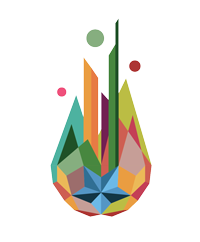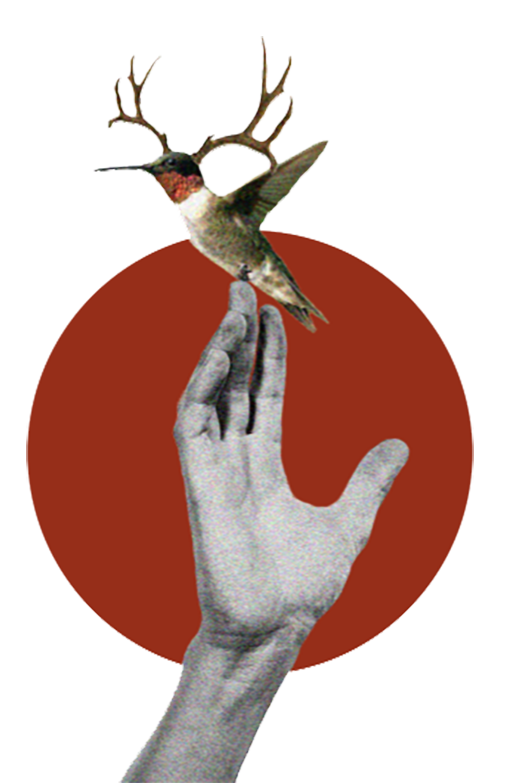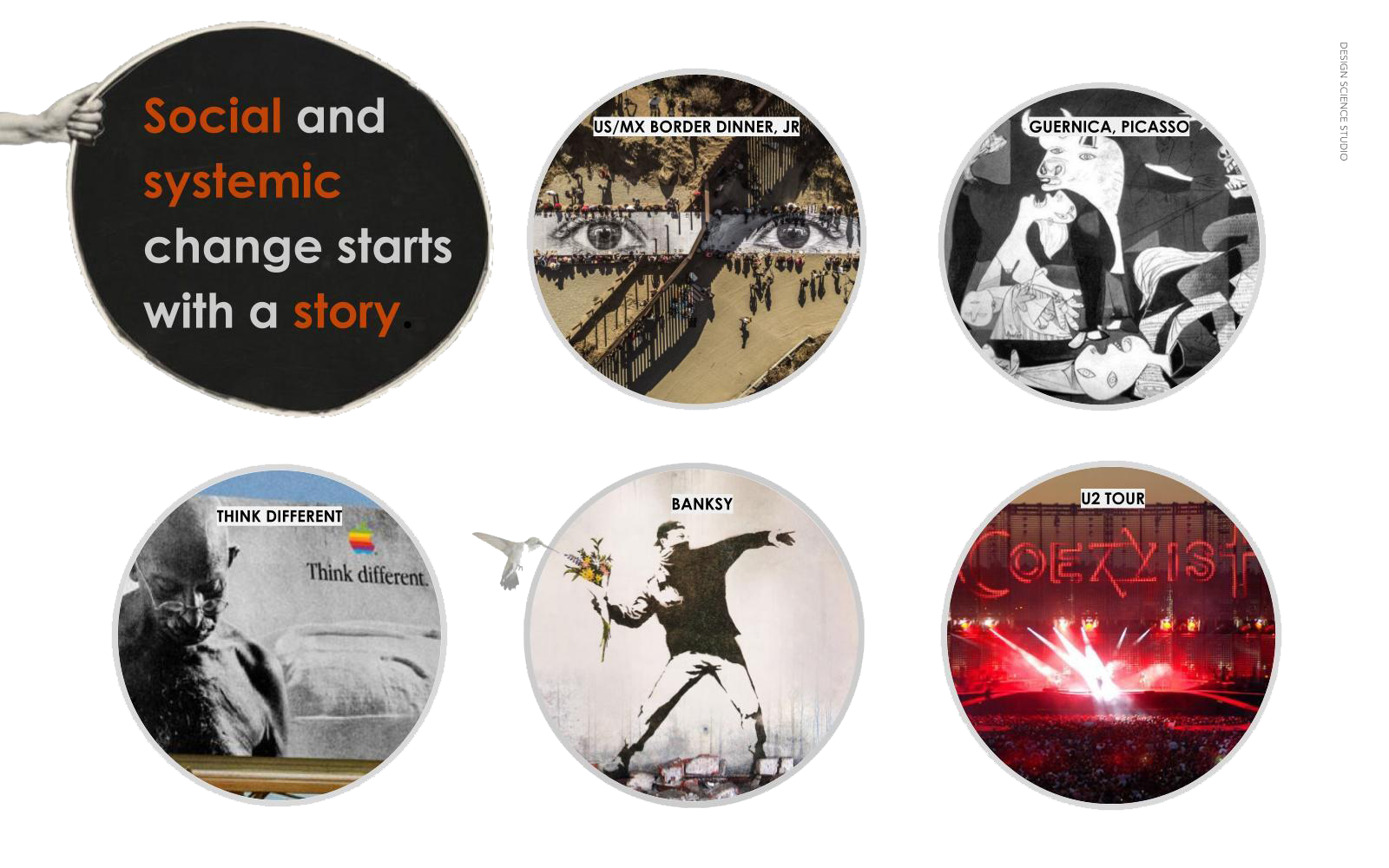
Design Science uses the latest technology to heal our ecology,
enabling humans to be a net positive to nature.
Design Science
Buckminster Fuller, the Leonardo DaVinci of the 20th century was way ahead of his time, he could see the future, anticipating humanity's needs and thus designed hundreds of artifacts for a world that works for 100% of life, all through looking to nature as design inspiration.
His methodology was called Comprehensive Anticipatory Design Science. We call it Design Science for short. You can think of it as a mash-up between design thinking, biomimicry, futurism, and regenerative development.
Buckminster Fuller called his whole-systems strategy
“comprehensive anticipatory design science.”
Comprehensive
Start with the whole.
Take a whole-systems perspective to explore connections within an integrated, complex world.
Anticipatory
Think ahead.
Identify, research, and interpret significant trends to gain a deeper understanding of possible futures.
Design
Create intentionally.
Seek and apply the elegant patterns and principles guiding the evolutionary strategies of nature.
Science
Discover through experience.
Generate hypotheses, iterate experiments, and rigorously verify through empirical observations.

The Role of Design
“If you are in a shipwreck and all the boats are gone, a piano top . . . that comes along makes a fortuitous life preserver,” Fuller once wrote. “But this is not to say that the best way to design a life preserver is in the form of a piano top. I think that we are clinging to a great many piano tops in accepting yesterday’s fortuitous contrivings.”
— Buckminster Fuller
Some of our Operating Principles…
Ontological Design
Ontological design is the design discipline concerned with states of being, existence and designing the human experience. It does so by operating under one essential assumption: that by designing objects, spaces, tools and experiences, we are in fact designing the human being itself.
The key assumption of ontological design is this: Everything we design outside of ourselves has an influence inside. In other words: as we design our tools, they design us in return.
By designing our environment, we are designing how we think and feel. By curating perception, we are designing reality. This is the operative engine of ontological design.
At the Design Science Studio we design processes of “human becoming”. By crafting experiences, architecting environments and curating information we are defining a systemic, creative approach to designing being, existence, and reality itself, and we do so based on the principles of nature, wellbeing and equity for all beings.
*thanks to Daniel Fraga and his inspiring article “The Manifesto of Ontological Design” from which we borrowed many words
Regenerative Development and Design
The field of design that is systemic and deeply considerate in nature.
Based on core principles inspired by nature, regenerative development and design aims to increase the vitality and viability of any system through multi-sector stakeholder engagement.
Regenerative design is developmental and considers the nested wholes at every level to aid in lasting systemic change.
“Spaces architect the mind” —
Jason Silva
Art that changes history
“The future is always first an idea”. This quote from Emilia Lahti has been our motto from the day we started on our mission to imagine a better future that works for all life.
Every (r)Evolution starts with a story and they develop as those stories are believed by more and more people.
Nature Magazine did a study and discovered that you only need 25% of a population to believe in something for that something to become mainstream. Decades of green activism and solutionism are finally coming out of the underground and joining the conversation. It’s the time to achieve critical mass.
A primary goal at the Design Science Studio is to create art, stories, experiences, books, paintings, street art, podcasts, gatherings, crypto art, ads… anything that can carry a message! These messages become tools to propel transformation.
There is no planet B, and we have a once-in-a-century opportunity to take everything we’ve learnt in the past hundred years and correct some of our mistakes. We still have an opportunity to re-align ourselves with nature and to design a world that accounts for all beings, where a sufficiency of resources exist for everyone. A world that is equitable and just, without colonization or racism, where all needs are served. A world that is in communion with nature, where we upcycle and recycle, where we grow in community and in harmony with our environment, where we create more human connections and work to live and not live to work.
Too hippie? Well, the future is always first an idea. Our work is to dream. Our work is to imagine. Our work is to empower those who can draft and sketch the future we want to inhabit and to give them wings to share those visions with the world, because we only need to convince 1 in 4 people that it is possible.
It’s time for Art that changes History.
Design Science Decade
This is the decisive decade for the future of our Spaceship Earth. What we do now will change the course of history forever. The difference between the best and worst case scenario has perhaps never been greater with climate collapse, income inequality, food insecurity, water shortages, systemic racism, indigenous genocides, and mass extinction all intertwining to create a Gordian knot. This complex knot leads us to pulling on one rope of a challenge and finding we are inadvertently making other challenges tighter and worse. In our best efforts to do good, we create harm in other systems and often at a higher order of magnitude. The trick to untying the knot is to look at the root causes and change the system, and follow Fuller’s axiom: “You never change things by fighting the existing reality. To change something, build a new model that makes the existing model obsolete”.
The best case scenario from this decade sees humanity realizing it is far more capable than it knows, to take care of itself and all life on Spaceship Earth. Fuller foresaw this transformational decade as the consequence of meeting a crossroads in the 1970’s where we finally had the technological ability to take care of all and could shift from scarcity to sufficiency. He said it would take about 50 years for all our institutions to catch up and shift from operating with a zero-sum game dynamic, in which one can only profit at the expense of another, to a win-for-all dynamic, in which all see benefit from others actions. Here we are 50 years later, watching our institutions crumble and be rebuilt upon this dynamic that could enable humanity to thrive indefinitely.
The task of the decade is to apply all our human ingenuity, creativity, and tools to transform from an economy based on dominance, exploitation, competition, and control to a new world economy based on consent, regeneration, cooperation and reciprocity.
And now as we emerge from the pandemic we find that people, communities, companies, and culture are ready for change. The clutch is in, will we shift up or down? We are in a critical moment, as Fuller says, it’s Utopia or Oblivion.
This is the most concentrated transition moment humanity has yet to experience. In the course of ten years we will build a new economy that works for 100% of life. We envision the future of our society evolving through these five themes
RECONCILIATION & Commitment
Here we lay down the deep groundwork for the decade, remembering the living systems understanding of the world that many indigenous cultures have practiced for millennia. We start to address the root causes of our interconnected crises. We begin to uphold the oppressed people and recognize them as a resource for resilience. We make wild commitments, without knowing the path to get there.
RESTORATION & Capital-Transfer
We will do mass tree planting that is already being committed to in this first phase. We will use this planting to also detoxify the earth through myco- and bioremediation. We will ban pesticides, first on public lands and then phase in a ban on crops. At the same time as massive planting, massive amounts of money in family wealth will be passed to the next generation and these millennials will divest from exploitation and invest in regeneration. Billionaires are going out of style, they are giving away enough to stay a millionaire.
RESILIENCE & Coming-together
As extreme weather and other shocks to the system continue, we will have the opportunity to upgrade our infrastructure. Our short-term reactions will build long-term resilience. Global temperatures won’t peak until 2053 at 1.526 degrees according to the latest Drawdown forecast and in the meantime we will have increasing fires, floods, storms and droughts that will require global cooperation for mitigation. This is not a time for selfishness, we will build a path to a more resilient world, through our emergency response.
REGENERATION & Celebration
This is the anticipated phase when all our work will bear fruit in a wave of regenerative good news. We will see indications of life rebounding all around our living Spaceship Earth. The latency of our decades of regenerative actions will catch up in a wave of healing, cooling, and grounding. Life will re-emerge and we will dance!
RE-ENCHANTMENT & Circularity
This will be the point that marks the end of the era of exploitation --we will close all the loops. No more mining will be needed, all resources will be either recovered or regenerative. We will grow in a way that regenerates ecosystems and communities. We will mine the landfills and then close them down.










